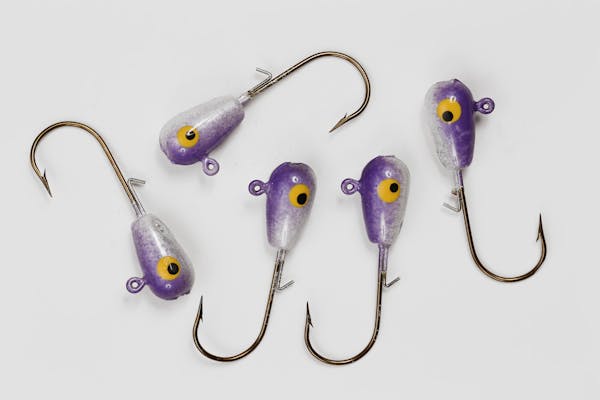As a teen, Donn Schrader maintained three aquariums in his bedroom, stocking them with a variety of fish. The act galvanized his fascination with the finned world.
"I did some breeding with tropical fish and played around with water conditions to see if I could get any of them to spawn," said Schrader, who eventually earned a fisheries management degree from the University of Minnesota. "I learned a lot from the experience. I guess you could say I've always had a passion for fish and found the right job."
Today, Schrader, 58, manages the historic St. Paul Fish Hatchery, established in the late 1870s on a few acres as the state's first facility to raise and stock fish in lakes and streams across Minnesota. In its early decades, the hatchery was a major tourist attraction for metro-area residents and their families.
On the eve of Minnesota's walleye opener, anglers who plan to fish the seven-county metro area, particularly the east metro, owe Schrader a debt of gratitude. Chances are "pretty good" any walleye you catch Saturday began its life at the hatchery he runs, Schrader said. He has worked there since 1987.
"Other than in our river systems, lakes in the metro by and large have walleyes because of stocking," he said. "Without walleye stocking, there probably wouldn't be a walleye fishery in metro. These lakes just don't have the spawning habitat for natural reproduction."
Each spring, Schrader — who is called "Papa Walleye" by some of his fisheries peers in the Minnesota Department of Natural Resources — receives 20 million to 30 million fertilized walleye eggs, extracted by DNR crews from several locations in northern Minnesota. The eggs come in large, heavy-duty plastic bags filled with water. "It's my job to 'hatch my kids' so they become little walleyes for people to catch," said Schrader, adding that roughly three out of four eggs hatch after 21 days.
"We have a pretty heavy load this year. We're about 45 million eggs to meet our quota," he said. "I've been doing this so long now I can pretty much look at a jar of fertilized eggs and guess the hatch rate. I'm usually pretty close. "
Once the eggs are hatched, the dark, microscopic newborns known as fry are transferred into water jugs before they leave the hatchery. Up to 40 percent are put into several small basins called rearing ponds, where by fall they'll grow into fingerlings (2- to 4-inch walleyes). Each autumn, crews at DNR fisheries stock roughly 8,000 pounds of walleye fingerlings in east metro lakes; another 15,000 to 18,000 pounds are stocked elsewhere in the seven-country metro area. The remaining fry go directly into the region's lakes.
"Fry are pretty vulnerable. They can just die, or they can become food for other fish," Schrader said. "The fry that survive are catchable in about three years."
Not all metro lakes are stocked with fry or fingerlings. That decision, Schrader said, is based on a lake's management plan, which factors in present fish species, the lake's size and depth, water quality, and more.
"One thing we've learned over the years through trial and error is that you just can't stock walleye fry or fingerlings in every lake," he said. "Some lakes just aren't suited for walleyes. But where you can stock, fry typically get good results. They're also less costly to stock than fingerlings."
Hatchery history
Steve Trimble of St. Paul is a former Minnesota legislator and history professor who has researched and written about the St. Paul Fish Hatchery for many years.
"I like writing about the history of the Twin Cities, and the story of the hatchery is a small but interesting part of our history," said Trimble, 72. "Not many people today are familiar with the hatchery, but it was once one of the most popular tourist attractions in the metropolitan area."
Established in 1877, the St. Paul Fish Hatchery was first called the Willow Brook Hatchery, then the Mounds Park Hatchery. Raising fish to stock in Minnesota's streams and lakes was — and still is — an important state mandate, and the site below the Dayton's Bluff area provided the perfect location.
The hatchery was originally meant as a holding, rearing and shipping station, owing its proximity to St. Paul's rail yard, according to DNR history. Thanks to the area's bluff lands, clean water fed by cold-water springs was ample and available. The water was diverted into channels and several hatchery ponds. A variety of fish species, from brook trout to walleye, were raised and transported statewide by railroad box cars. Milk cans were used as shipping containers.
"People and families, in carriages, would come to the hatchery to spend the day," Trimble said. "It was a great place to walk, look at the fish, have a picnic and take in the views of the Mississippi, which were and still are very scenic. At one time, there was even a small zoo on the premises with animals from Minnesota."
The hatchery grounds had grown to 22 acres in the early 1900s, and the site became such an attraction that the St. Paul Association of Commerce extolled its virtues in a tourism pamphlet. It read, in part: "There is no more beautiful spot around Saint Paul on a summer's day than this pretty little valley, far from the sounds of the great city — the wooded hills carpeted with emerald grass … the many-colored trout jumping in little ponds, and the great river sliding lazily in the sunlight."
By the 1930s, Trimble said, increased automobile use allowed recreation-seekers to travel outside of St. Paul and the metro area. "Interest in the hatchery as an attraction started to decline," he said.
Over the years, the hatchery has been remodeled several times. Beginning in the 1960s, the hatchery operations were downsized. Only two of the seven original spring-fed ponds are now in use, and the hatchery and the buildings serve as the headquarters of the DNR's central region. In 1994, the hatchery's cold-water portion was closed. In addition to walleye, the hatchery produces pure-strain muskie fry and some hybrids.
Busy season
Spring is Schrader's busy season at the hatchery. "Papa Walleye" pretty much works seven days a week baby-sitting his fertilized walleye eggs. Soon they'll hatch and be released into the wild. Before long, they'll be old enough for anglers to catch. Schrader takes pride in that.
"Sometimes it gets a little hectic, but I enjoy what I do, because I know it's important to anglers," he said, adding he "occasionally" thinks of the hatchery of old.
"I have some of the old photos, and I know where all the old raceways were at. When I walk the grounds, I try to picture in my mind what it used to look like. It's a much smaller facility today, but it serves a vital function."
Tori J. McCormick is a freelance writer from Prior Lake. Reach him at torimccormick33@gmail.com.

Reusse: How bad are the White Sox? They made Twins look good.
NFL draft has been on tour for a decade and the next stop is Detroit, giving it a shot in spotlight

Souhan: Wolves fans made Game 1 special. Now bring on Game 2.

Will Wolves show best-in-the-NBA defensive form in Game 2?

